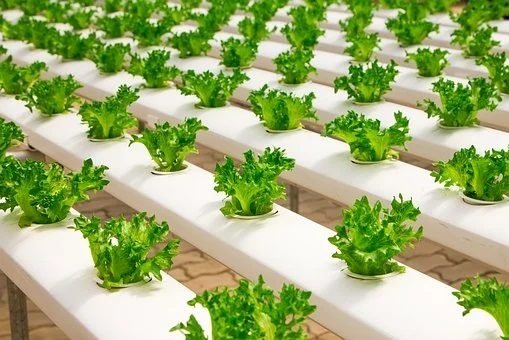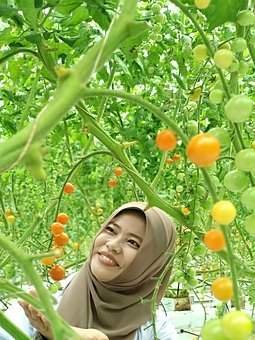Summary
Hydroponics is a method of growing plants without soils, instead it is grown in a water based, nutrient rich solution. It uses less water than soil based methods of gardening. It uses 20 times less water.

The nutrients used in the solution are: fish excrement, duck manure, and fertilizers.

Types of hydroponic systems.
- Wick System
- Deep Water Culture
- Nutrient Film Technique
- Ebb and Flow (flow and drain)
- Aeroponics
- Drip system
Let’s take a look at these systems.
The Hydroponics Wick System
The hydroponics Wick System is the most basic form of hydroponics. This system is not complex, it has no moving parts, and are therefore easy to maintain. Plus, the things you need to build such a system is cheap.
Now the wick system is obviously not as good as the other system when it comes to growing large plants. Large plants consume a lot of water and the wick system will not work well. So, the best plants to grow using the wick system are lettuces or herbs. They require not much water. You cannot use this system to grow tomatoes; they require a lot more water.
The wick system allows the roots to always be in contact with the water. This water has two or more wicks that send water from the reservoir to the roots.
Here are four main components of a Wick System:
- the grow tray –
- The reservoir
- the wick, and
- the aeration system.
Here is a video on how the Wick System works. Further, the video below show how to build a hydroponics system using a soda bottle.
Deep Water Culture
Deep Water Culture (DWC) is a hydroponic method of plant production. It involves suspending the plant roots in a solution composed of water and nutrients. The solution has three parts: oxygen, water, and nutrients.
In this method, the roots are submerged in water and not soil. The water needs to be well oxygenated, so the plant doesn’t drown. The plant is grown in a reservoir that can hold a decent amount of water. This is a simple system. It does not require much maintenance, and the plants grow very fast. However, you must maintain the pH water level, and nutrient concentration of the water. If you have an electricity outage or a pump failure, your roots may “drown” in low-oxygen nutrient solution. Also, it might be, it can be difficult to maintain a consistent water temperature
Video: Deep water culture
Nutrient Film Technique
The Nutrient Film Technique (NFT) in Aquaponics is a hydroponic growing technique to grow plants in a long narrow channel. This is a simple and effective design for plants that have short roots.
In NFT, a thin film of water flows continuously down each channel providing the plant roots with water, oxygen, and nutrients. As soon as the water reaches the end of the channel, it flows back to the fish tank using gravity. This system requires a separate filter to clear the water of solids and biological waste.
Ebb and Flow (Flood and Drain)
Ebb and Flow Systems of Hydroponics is the most recognized hydroponics system. In this system the plants are placed in a tray. The tray is often filled with nutrient-rich water pumped in a timely basis from a reservoir below. The system uses gravity to do this. This system requires little maintenance and cost to set up. It is ideal for plants that are used to alternating periods of dryness to wet.
The four basic components of an ebb and flow system are the reservoir with your nutrients, a plant or flood tray, a submersible water pump, and a timer.
Aeroponics
Aeroponics is the process whereby the plants grow in an air or mist environment without the use of soil or aggregate medium. This system differs a bit from hydroponics and aquaponics.
The components are a reservoir/container to hold the aeroponic nutrient solution, a nutrient pump, mist nozzles, tubing to dispense water, grow baskets or pots,containers for the growing chamber, and a timer.
Drip System
The drip system uses a pump to feed the plants with nutrients and water regularly. in a slow dripping action. The system was developed to improve water efficiency for plants cultivated outdoor. this type of set is best suited for large growing operations.
The components for a drip system are: a container for the plant’s roots to grow in, a
container (reservoir) to hold the nutrient solution, a submersible fountain/pond pump, a light timer to turn the pump on and off, tub tubing to run from the pump in the reservoir to the plants.
Which Hydroponic System is better?
Activity
The container does not water itself, really. This is a watering system that has a reservoir of water at the bottom. The reservoir is connected to the soil foot or a fabric wick.

In a soil foot system, the plants sends it roots down in the foot, and draws up the needed water. In a wick system, the water is drawn up the wick via capillary action in the soil of the pot.
Therefore, you don’t have to always water the plants.
Self-watering systems are great for a wide variety of plants: garden plants and even house plants.
Project:
Create a simple self-watering system for growing a plant of your choice using recycled materials. Record the growth of the plant using a table, pictures or drawings.
Planting Guidelines:
You may plant a vegetable or herb in a container. If you are planting seeds, select healthy seedlings. Make sure they are not too old. A healthy seedling has a shoot:root ratio of about 2:1 and 5-6 leaves. It should be at least 5 cm (2 inches) with white roots.
Place your plant in a pot. Be careful not to cover the base of the first leaves with soil. Ensure seedlings are firmly positioned by pressing the soil around it with your hands. Keep the plant free from weeds at all times.
Water the plants immediately after transplanting. Remember to use clean water to irrigate the plant.
